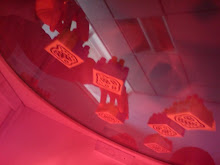The reacTogon uses MIDI to generate sound, and its prooving pretty hard to find much imformation on it, but like the ReacTable Im sure that I must just dig a little harder to find out the really interesting information. I was unable to ind out what software the ReacTogon uses but I was able to find another peice of software that was inspired by it.
http://www.youtube.com/watch?v=jxSP5ZP8IHo&feature=player_embeddedThis is called elysium and was created by Matthew Mower in 2008 and is inspired by the ReacTogon.
But what is Elysium?
Straight from the Elysium webwite " Elysium is an interactive generative MIDI sequenser"
"Elysium is a sequencer, that means it’s designed to produce sequences of notes that can be layered to form music.
Elysium uses MIDI which means that it doesn’t make sounds itself but can drive MIDI based synthesizers, samplers, and other instruments. It also means that Elysium’s output can be recorded, and manipulated, in a DAW such as Logic or Ableton Live.
Elysium is generative which relates to the way the music is created by building up a “system” composed of layers, cells, tokens, and playheads that combined, when “played”, to produce a sequence of notes.
Elysium is interactive. Features like MIDI CC control and MIDI trigger mode allow you to take control and integrate generative elements into the music you make and play."
The great thing about this is that Elysium is open source like TUIO and ReacTivision. The down side for me is that Elysium only runs on Mac opperating systems lepard and snow lepard, and as I only have tiger running on my mac I can not use this software.
Luckly for me ReacTIVision and TUIO both work with my operating system, which is one reason why I have decided to create a reacTable.
The Elysium software screen dump looks just like the reacTogon's musical interface and ind if you what the video demo you can see that it looks and behaves just like the reacTogon does and is one way in which you can see how the reacTogon has inspired it.
Full instructions on how to download and make a symple midi sequencer useing Elysium can be found on thie following website:
http://lucidmac.com/products/elysium/
 The above object shows the direction of sequence flow and it also deturmins the first note. The note in which the sequence will start will depend on which cell the marker is placed.
The above object shows the direction of sequence flow and it also deturmins the first note. The note in which the sequence will start will depend on which cell the marker is placed.




